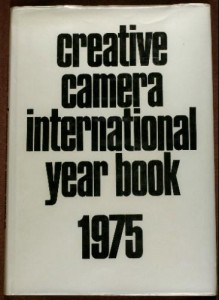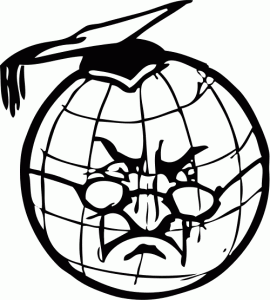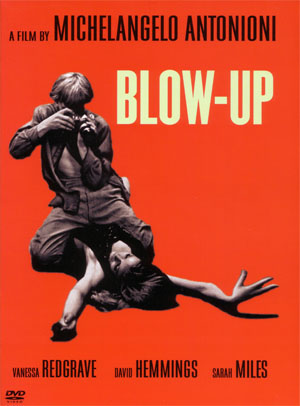 [Forty years ago, in 1975, I published another installment of what had become an ongoing rumination on the state of post-secondary photography education. It first appeared in the Creative Camera International Year Book 1975; you’ll find it also in my 1979 collection of essays, Light Readings. Portions of it still seem relevant to the current condition of that now much expanded industry. I offer it here to any graduating class that wants it, free of charge, as a commencement address from an uninvited guest speaker. The first part appears below, click here for the second part. — A. D. C.]
[Forty years ago, in 1975, I published another installment of what had become an ongoing rumination on the state of post-secondary photography education. It first appeared in the Creative Camera International Year Book 1975; you’ll find it also in my 1979 collection of essays, Light Readings. Portions of it still seem relevant to the current condition of that now much expanded industry. I offer it here to any graduating class that wants it, free of charge, as a commencement address from an uninvited guest speaker. The first part appears below, click here for the second part. — A. D. C.]
•
My Camera in the Olive Grove:
Prolegomena to the Legitimization of Photography
by the Academy
The past decade has borne witness to a new and surprising phenomenon: a dramatic increase in the academic acceptance of photography as a serious field of creative and scholarly inquiry, and, as the inevitable corollary thereof, the rise of a photography academy whose structure, function, and attitudes are analogous (and, in most cases, essentially identical) to current versions of the more established academies within such media as painting and literature.
The prime symbol and crowning glory of this sudden ascension, at least on this side of the Atlantic, was the establishment in 1972 of the David Hunter McAlpin Professorship of the History of Photography and Modern Art at Princeton University. That segment of the photography community which is still caught up in the battle for photography’s recognition as a “legitimate” art form has taken great satisfaction from this specific development and the larger iceberg it implies.
Certainly, on a ritualistic level, it is a formal vindication of Alfred Stieglitz, his apostles and descendants, and their years of struggle to win a place for photography within the charmed inner circle of the “high” arts. (That the man for whom this $1-million chair was custom-built — Peter Bunnell, former curator of the Museum of Modern Art’s Department of Photography — wrote his doctoral thesis on Stieglitz adds an appropriate symmetrical fillip).
 Such an unexpectedly warm welcome is naturally intoxicating. Yet, after more than a century of academic scorn as the illegitimate offspring of the sciences and the graphic arts, it might be wise — if only on principle — for the photography community to be somewhat less eager and more cautious upon being clasped to the bosom of the aesthetic nuclear family.
Such an unexpectedly warm welcome is naturally intoxicating. Yet, after more than a century of academic scorn as the illegitimate offspring of the sciences and the graphic arts, it might be wise — if only on principle — for the photography community to be somewhat less eager and more cautious upon being clasped to the bosom of the aesthetic nuclear family.
To have “legitimacy” thus instantly conferred is at best a mixed blessing. For anyone who takes photography seriously, it is of course gratifying on one level to witness an increased attention to the medium from art critics, galleries, museums, collectors, and institutions of higher learning. On another level, however, acquiescence to the elevation of photography from the ranks of the “low” arts tacitly affirms the validity of a hierarchy among the arts.
This peerage is a hoary construct, deeply rooted in capitalistic premises. Its fundamental principle is an aristocratic one: that a medium’s stature and significance are not to be gauged on internal qualities — i.e., the caliber of the work done by its exponents — nor on such work’s effect upon the external world, but are instead proportional to that work’s financial worth, inaccessibility, and lack of functional utility. The high arts, after all have always been those which only the leisure class could afford to pursue.
For those of us who are seeking the elimination of this archaic, elitist concept of art, the reaffirmation of that aesthetic stratification, with its obvious allegiance to the class system, may understandably be viewed as counterproductive. Photography is inherently a democratic medium; anyone concerned with the cultural shortsightedness which has ensured the accuracy of Moholy-Nagy’s frightening prediction of visual illiteracy cannot help but look askance at such priorities. In evaluating photography’s newly-conferred academic respectability, then, it is important to take note of the implicit premises thereof. Wrapping the mantle of scholarly approval around a medium which has received the cold shoulder from birth is surely a significant attempt at redefinition.
Simultaneously, we must look closely at the emerging photography academy itself, in order to examine the implicit and explicit definitions of photography which it propounds. Photography is a unique medium in many ways, one of which is that it is enormously widespread and highly diversified in its utilitarian, communicative, and creative functions, yet young enough to have developed only a few centralized power blocs. These loci therefore exercise an ability to shape our definitions — and thus our culture’s understanding of photography — which is quite disproportionate to their age and size.
The new photography academy is certainly one of these. Paradoxically, to consider its influence at length is to risk extending that influence; yet we cannot afford to ignore it. It is unlikely that it will simply go away.
•
“I think today you are seeing the beginnings of a very significant decline in the number of photographers who will be producing serious work for the simple, basic reason that their primary economic source is drying up, which is teaching. It’s absolutely true. We have no monopoly on it, but we’ve got a very, very high percentage of our people who are fundamentally in the teaching profession as a vehicle to support what in fact is an art that is not being supported through any other vehicle.”
— Peter Bunnell, The Print Collector’s Newsletter, Vol. IV, no. 3, July-August 1973
Though it may be looser structurally, on a practical level an academy operates in patterns common to such kindred organizations as craft guilds and trade unions. One of the primary functions of such institutions is to promote the interests of their members by venerating and propagating standards of performance which, not coincidentally, reflect with considerable accuracy the capabilities, work habits, and taste patterns of those who belong to them.
A standard is a goal whose achievability has been proven beyond question. Within a guild/union context, standards proclaim what can be accomplished comfortably and decorously. No such organization has ever propounded standards which could not be met with relative ease by the lowest common denominator of its membership. No goldsmith’s guild ever drums out all but the Cellinis. Standards embody the average competence of those who subscribe to and promulgate them. Such standards are maintained by limiting the number of licensed practitioners and requiring that new licensees be trained by older ones. In guild and union situations, this takes place through the process of apprenticeship: learning to do something the way someone else does it.
Until quite recently, this transmission of craft competence was the sole thrust of formalized photography education. As a beginning, this was necessary. There were few textbooks — much less organized, coherent programs — dealing with the problems and issues of creative (as opposed to commercial) photographic image-making. Consequently, the best and often the only sources for relevant information were those few individual master photographers who had pulled together some coherent, communicable modus operandi from their own experience and were willing to disseminate their personal know-how in the classroom.
 This was certainly better than no photography education at all, but it had numerous flaws. One of these was the creation of a star system under which a particular college, university, or art institute would be considered photographically significant not because it had, say, an intelligently structured and well-rounded program which gave students a thorough grounding in the history of the medium and all the diverse processes it encompasses, but rather because Harry or Aaron or Minor or Ansel or Jerry was teaching there. To be sure, there’s nothing wrong with wanting to know how Harry or Aaron or Minor or Ansel or Jerry “does it,” but the leaking of one’s trade secrets to (and the infliction of one’s taste patterns on) a group of students hardly constitutes a formal educational methodology.
This was certainly better than no photography education at all, but it had numerous flaws. One of these was the creation of a star system under which a particular college, university, or art institute would be considered photographically significant not because it had, say, an intelligently structured and well-rounded program which gave students a thorough grounding in the history of the medium and all the diverse processes it encompasses, but rather because Harry or Aaron or Minor or Ansel or Jerry was teaching there. To be sure, there’s nothing wrong with wanting to know how Harry or Aaron or Minor or Ansel or Jerry “does it,” but the leaking of one’s trade secrets to (and the infliction of one’s taste patterns on) a group of students hardly constitutes a formal educational methodology.
One central issue in photography education (and, for that matter, in photography criticism) is the necessity for developing a useful, comprehensive, nonsectarian vocabulary for discussing the expression and communication of ideas, feelings, and perceptions through photographic imagery. The lack of such a vocabulary is among the crucial problems in contemporary photography. It was surely perpetuated by the star system, which encouraged students to mimic the dialect of one or another individual image-maker, instead of evoking a mother tongue for them and encouraging proficiency therein. During this period, students from different schools often had so little in common that they could not even discuss their differences profitably. This problem has been and continues to be compounded by inarticulate photographer-teachers who delude students into the false belief that verbal incompetence and illiteracy are a photographer’s badges of honor.
Nevertheless, one can also point out some highly beneficial results of this apprenticeship system. The general level of craftsmanship among students of creative photography rose markedly across the board during that stage in the growth of photography education, and it also spread much more widely than might have been expected, due to an explosion of interest in studying photography which began in the early 1960s. This is not the proper place to trace the causes of that upsurge, which are multiple and complex, ranging as they do from increased affluence among the young to Michelangelo Antonioni’s 1966 film Blow-Up. Suffice it to say that during that decade colleges, universities, and art institutes across North America added new photography departments and expanded extant ones. This in turn created a booming market for teachers of photography, fostering the illusion that anyone with a Master of Fine Arts in creative photography could always “fall back on teaching” to support him/herself.
(Part 1 I 2)
© Copyright 1975 by A. D. Coleman. All rights reserved. By permission of the author and Image/World Syndication Services, imageworld@nearbycafe.com.








I happen to be one of those purveyors of photo education in academe. I was fortunate to be able to start a photography program at the University of Cincinnati in 1962. The program still exists today, albeit quite different from those ancient beginnings.
I would like to say that I have enjoyed most of your work over the years and quite often use your statement about having to wade through adequacy to find something worth writing about. It has to be even more problematic today.
I guess I enjoy “My Camera in the Olive Grove” because I was there. I’m looking forward to part 2.
Thanks, js